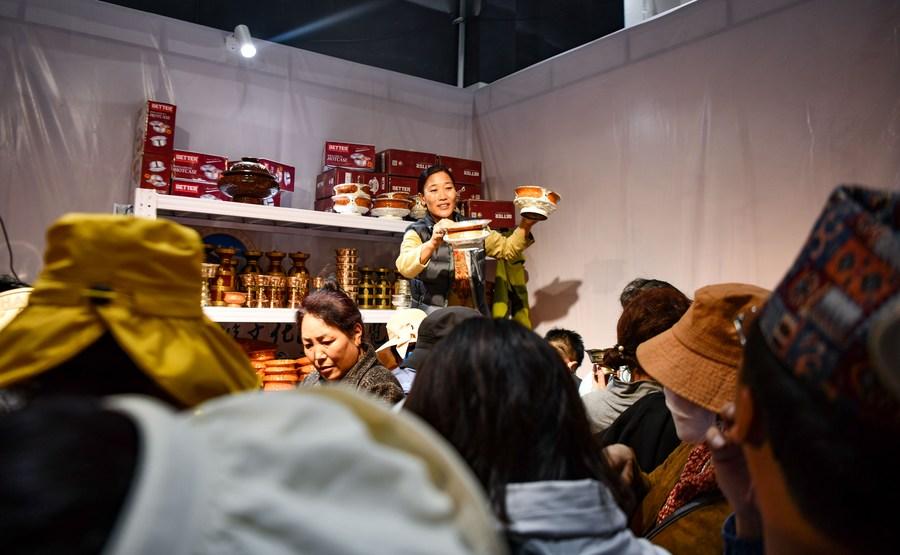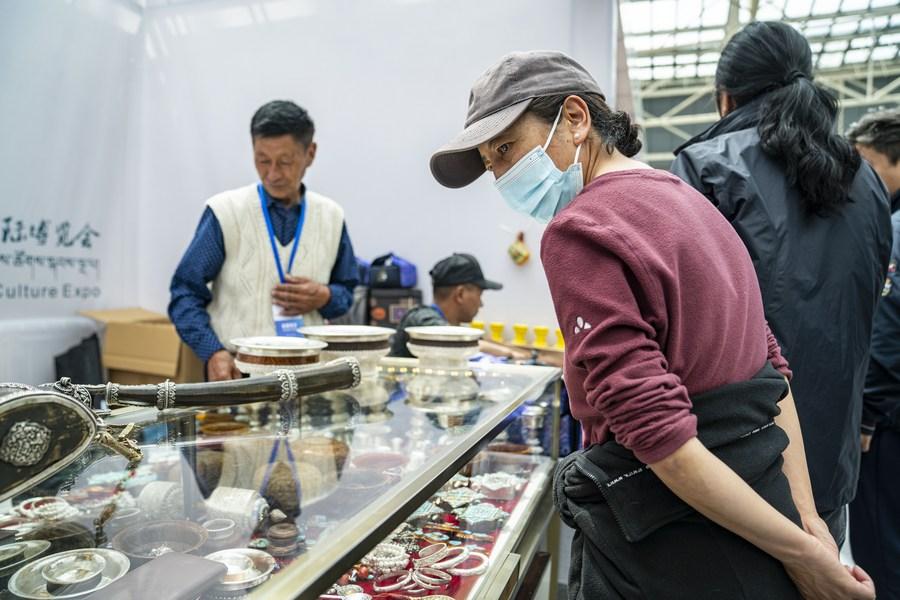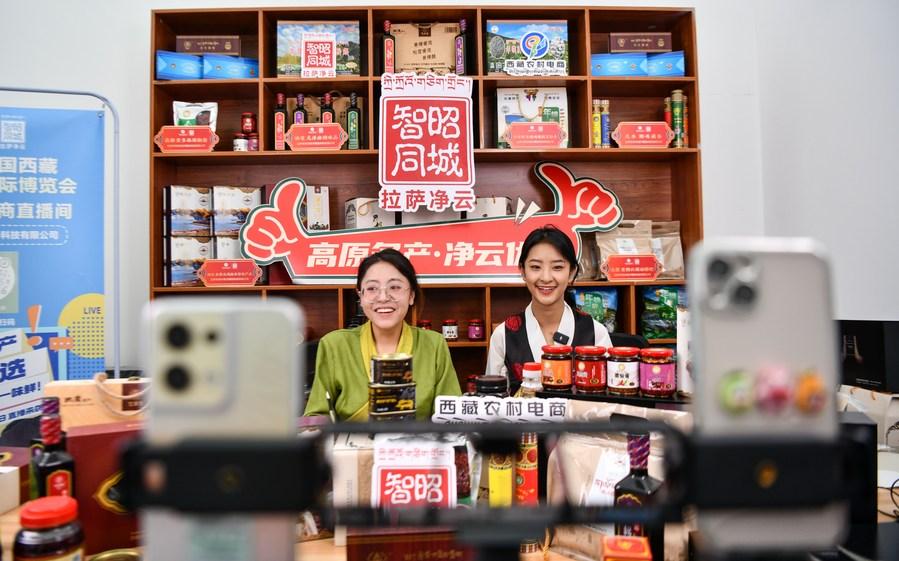
A trader sells Tibetan bowls at the 5th China Xizang Tourism and Culture Expo in Lhasa, capital of southwest China's Tibet Autonomous Region, June 18, 2023.(Xinhua/Jigme Dorje)
by Cao Bin
There was great excitement throughout Tibet last weekend, as "the expo" became a buzz phrase tossed around frequently by people around me.
What they were referring to was the fifth "China Xizang Tourism and Culture Expo" held from June 16 to 18 in the regional capital of Lhasa.
The expo, linking local consumers and enterprises in Tibet with the outside world, displayed all kinds of intangible cultural heritages, and cultural and creative products, in the city's grand convention and exhibition center.
Upon arrival, I first noticed the majestic model of Mount Qomolangma, the world's highest peak, at the very center of the hall, and I became a little bit lost in its solemnity.
However, this serenity proved temporary, as I was soon surrounded by the hustle and bustle on site. All I could hear were chats between merchants and purchasers from home and abroad and their swift footsteps.
A local resident who came to the exhibition summed the scenes up well by telling me "the place is crowded with people, a scene I haven't seen for years. Some booths almost overturned due to the enthusiastic visitors!"
A Tibetan exhibitor was eager to show me his products -- so very enthusiastic and full of passion. "I am so glad that everything has returned to normal. My business is even better this year," he said.

A visitor looks at Tibetan handicrafts at the 5th China Xizang Tourism and Culture Expo in Lhasa, capital of southwest China's Tibet Autonomous Region, June 18, 2023.(Xinhua/Sun Fei)
His words reminded me of a famous saying that goes: "Confidence is more precious than gold." The expo really stands out for its scenes of prosperity, full of people's great hopes for a better life.
In the first five months of this year, Tibet, one of China's most sought-after tourist destinations, received more than 11.73 million visitors, a rise of nearly 45 percent year on year. The swarm of tourists also delivered huge profits to Tibet, as its tourism revenue over the period surpassed 13 billion yuan (about 1.8 billion U.S. dollars), up about 43 percent from the same period in 2022.
The evident market vitality in the tourism sector is merely a glimpse of the region's robust economic growth as a whole. Over the past months since I arrived here, I have seen increased business exchanges and activities, including newly-opened fancy shopping malls and high-end restaurants, which have attracted people from all walks of life.
During the three-day expo, deals concerning 60 projects with a total value of over 53 billion yuan were inked, covering fields such as clean energy, modern services, biomedicine and border logistics.
What impressed me even more were the roughly 300 varieties of local signature exhibits, such as tsampa (roasted highland barley flour), wooden bowls and handicrafts. They were mostly transported to Lhasa from Tibet's remote agricultural and pastoral areas.

A Nepalese trader poses for a photo at the 5th China Xizang Tourism and Culture Expo in Lhasa, capital of southwest China's Tibet Autonomous Region, June 18, 2023.(Xinhua/Jigme Dorje)
It was the first time I got to see cashmere sweaters and shawls made in Ngari Prefecture with my own eyes. Nearly 1,500 km away from Lhasa, the prefecture is often dubbed the "roof" of the Qinghai-Tibet Plateau, known as the "roof of the world."
According to staff at the cashmere booth, their products have been sold across China and even exported to South Asia over the years, thanks to improved local transport and logistics.
For a long time, farmers and herders in Tibet were troubled by the inconvenience of transportation. Products with Tibetan characteristics used to have few opportunities to reach beyond their origins, but that hard time is now gone.
The total length of roads in Tibet has more than doubled over the past decade, more than half of which are rural roads, according to official figures in 2022.
Nowadays, even hand-made products produced by farmers and herders can reach the overseas market through online e-commerce platforms and offline exhibitions just like the expo.

Tibetan specialties are being sold via livestreaming at the 5th China Xizang Tourism and Culture Expo in Lhasa, capital of southwest China's Tibet Autonomous Region, June 18, 2023. (Xinhua/Jigme Dorje)
With increased incomes and more interactions with customers, the local farmers and herders have become more confident and open-minded, said an on-site official from the regional department of commerce.
This is indeed true, as proven time and again during my own visits to rural areas across the region.
Besides local exhibitors, the event's organizer also told me that 60 companies from 16 countries, including Nepal, India, Vietnam and Italy, participated in the expo, displaying 630 types of commodities. Yak butter tea powder, a local delicacy, could be found next to imported chateau wine -- what a magical blending of Tibetan and global flavors!
While I was wandering around in the exhibition hall, a Douyin (Chinese version of TikTok) influencer walked past me. Dressed in a gorgeous Tibetan costume and wearing exquisite makeup, she was greeting her online followers in a livestreaming session: "Welcome to the expo full of hope!"